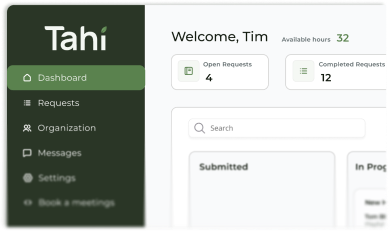SEO & Analytics
Goal Tracking That Actually Matters (Without the GA4 Headache)
Drowning in GA4 data but starved for insights? Learn how to set up simple, effective goal tracking that focuses on what truly matters for growth.
Are Your Website Analytics Actually Helping?
For many businesses, opening Google Analytics 4 feels less like gaining clarity and more like preparing for a data-induced migraine. You’re bombarded with engagement metrics, attribution models, and a sea of acronyms. You have more data than ever, but are you any closer to understanding what’s actually working on your website? For most, the answer is a resounding no.
The problem is that we’ve been conditioned to chase vanity metrics. We obsess over traffic spikes and session durations, but we fail to measure the small, crucial actions that signal genuine user interest. It’s like having a shopkeeper who tells you exactly how many people walked through the door but has no idea if anyone actually touched the merchandise. It's interesting, but utterly useless for making smart business decisions.
A website should be your hardest-working employee, not a source of confusion. To make that a reality, you need to track goals that matter. Not just the big, obvious ones like a final purchase, but all the tiny 'yes' moments along the way. This guide will walk you through how to set up meaningful goal tracking, so you can finally get actionable insights from your data, with or without the GA4 headache.
Macro vs. Micro: The Two Types of Goals You Need
To get started, we need to separate our goals into two simple buckets: macro and micro. Understanding this distinction is the first step to building a measurement plan that makes sense.
Macro Conversions: The Big Wins
These are the primary objectives of your website. They are the finish line, the actions that directly contribute to your bottom line. Think of them as the main reason your website exists.
- Making a purchase on an e-commerce site.
- Submitting a lead form for a service business.
- Signing up for a paid subscription on a SaaS platform.
These are easy to identify and, thankfully, most businesses are already tracking them. But focusing only on macro conversions is like only watching the last five minutes of a film; you see the ending, but you have no idea how the characters got there.
Micro Conversions: The Story in the Middle
Micro conversions are the smaller steps a user takes that indicate they are moving towards a macro conversion. These are the breadcrumbs that show engagement, build trust, and predict future success. They are the most overlooked, yet most insightful, part of the user journey.
We see it all the time with new clients. They have plenty of traffic, but their marketing site isn't converting. Why? Because they have no visibility into the micro-conversions. They don't know which call-to-action (CTA) is working, which PDF is being downloaded, or where users are dropping off. They're flying blind.
Tracking these smaller actions is how you start to understand user behaviour and answer the crucial question: is your website truly working?
Key Micro-Conversions You Should Be Tracking Now
The specific micro-conversions you track will depend on your business model, but here are some of the most valuable examples that apply to almost everyone.
- Newsletter Sign-ups: A user giving you their email is a massive signal of trust. They are giving you permission to enter their most personal digital space: their inbox.
- Resource Downloads: When someone downloads a white paper, case study, or checklist, they are telling you they have a problem and believe you might have the solution.
- 'Add to Cart' Clicks: For e-commerce, this is the critical step between browsing and buying. A high number of 'add to cart' clicks with a low purchase rate points to a problem in your checkout process.
- Demo or Consultation Bookings: For SaaS and service businesses, this is often the most important micro-conversion. It signifies a user is ready to have a sales conversation.
- Video Plays: If you've invested in video content, you need to know if people are watching it. Tracking plays, or even how much of a video is watched (e.g., 25%, 50%, 75%), tells you how engaging your content is.
- Key CTA Clicks: Do you have a prominent 'View Pricing' or 'See Our Work' button? If you're not tracking clicks on it, you have no idea if your core messaging is effective.
By tracking these interactions, you move from guessing to knowing. You build a clear picture of your user journey and can start making data-driven improvements to your entire digital ecosystem.
Beyond GA4: Tools That Prioritise Clarity
While GA4 is undeniably powerful, its complexity can be a significant barrier. For many businesses, the time spent wrestling with its interface is time that could be spent acting on insights. Luckily, the analytics market has exploded with alternatives that prioritise simplicity, privacy, and actionable data.
For Simplicity and Privacy
If you're tired of cookie banners and complex reports, privacy-focused tools are a breath of fresh air. Platforms like Plausible and Fathom Analytics offer lightweight, cookieless tracking. They give you the core metrics you need without collecting personal data, meaning you often don't need an annoying cookie banner. Their goal-tracking features are incredibly straightforward, allowing you to set up key conversion events in minutes, not hours.
For Deep Event-Based Insights
If you love the idea of tracking everything but want a more intuitive interface than GA4, event-based platforms are the answer. A tool like PostHog is built from the ground up to track user actions. It allows you to build funnels, analyse user paths, and track revenue in one place. Its event-based model is perfectly suited for measuring the micro-conversions we discussed, giving you a granular view of user behaviour.
For Comprehensive Attribution
One of the biggest challenges in marketing is understanding which channels are actually driving conversions. This is where multi-touch attribution comes in. While GA4 has attribution models, specialised tools like The Attribution Platform go much deeper. They help you connect every touchpoint, from the first ad a user saw to the final blog post they read, to the ultimate sale. This level of insight is crucial for optimising your marketing spend and avoiding wasted budget.
A Simple 3-Step Plan to Meaningful Goal Tracking
Ready to get started? It’s simpler than you think. You don't need to track a hundred different things. You just need to track the right things. Here’s a clear, phased approach to get you going.
Step 1: Define What Actually Matters
Before you touch any tool, grab a pen and paper. Forget the jargon and ask one simple question: "What actions on our website indicate a visitor is becoming a customer?"
Start by identifying your one or two macro conversions (e.g., 'Purchase Completed', 'Contact Form Submitted'). Then, brainstorm 3-5 key micro-conversions that lead to them (e.g., 'Clicked View Pricing', 'Downloaded Case Study', 'Subscribed to Newsletter'). Write them down. This is your measurement plan. It doesn't need to be more complicated than that.
Step 2: Choose Your Tool and Set Up Core Tracking
Based on the list above, select the analytics tool that best fits your needs and budget. Whether it's a simple tool like Plausible or a more advanced one like PostHog, the first task is the same: install the tracking script and set up your macro conversions. This is your foundation. Ensure you can reliably measure your most important business outcomes before you do anything else.
Step 3: Layer in Your Micro-Conversions
With your foundation in place, it’s time to add the context. Using your tool's event or goal tracking features, set up tracking for the 3-5 micro-conversions you identified in Step 1. This is where the real story begins to emerge. You’ll start to see not just *if* people convert, but *how* they convert.
This is a process of continuous improvement. As a Webflow agency, we often work with Conversion Rate Optimisation (CRO) experts to dig deep into this data. They help us and our clients connect the dots, identifying the specific user behaviours that lead to growth and highlighting areas of friction that are costing sales. It's about turning data into direction.
Using Your Data to Make Smart Decisions
Setting up tracking is only half the battle. The real value comes from using that data to make better decisions. Your goal tracking should answer specific business questions and guide your strategy. Here’s how that looks in practice:
- If you see... a landing page has high traffic but a low 'Demo Request' conversion rate. You can ask... "Is the CTA clear? Is the form too long? Is the copy compelling?" Then you can A/B test changes to improve performance.
- If you see... many users click 'Add to Cart' but abandon the checkout process. You can ask... "Are there surprise shipping costs? Is the process too complicated? Do we require users to create an account?" Then you can streamline the checkout flow.
- If you see... a blog post is driving a high number of newsletter subscriptions. You can ask... "What is it about this topic that resonates? How can we create more content like this?" Then you can double down on your most effective content pillars.
This is the loop of continuous improvement: Measure, Learn, Act. Without meaningful goal tracking, you’re stuck on the first step, accumulating data without wisdom. By focusing on the actions that matter, you build a powerful engine for growth, ensuring your website is an asset that constantly evolves and improves. This isn't about avoiding technical debt; it's about building a foundation of business intelligence.
Conclusion: From Data Overload to Actionable Clarity
The goal of analytics isn't to collect the most data; it's to gain the most clarity. Stop letting complex platforms dictate what you measure and start focusing on the handful of user actions that genuinely drive your business forward. By shifting your focus from vanity metrics to meaningful micro-conversions, you transform your website from a static brochure into a dynamic tool for growth.
Define what matters, choose a tool that empowers you, and use your insights to make smarter, faster decisions. That’s how you build a website that doesn’t just look good, but performs brilliantly.
Feeling overwhelmed by your current analytics setup? Let's clear the fog. Get a free site audit from us. We'll analyse your site and give you a handful of actionable insights to get you started on the path to clarity.








